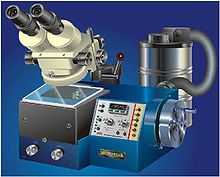Ultramicrotomy
Ultramicrotomy is a method for cutting specimen into extremely thin slices or sections, that can be viewed in a transmission electron microscope (TEM).[1] It is used mostly for biological specimens, but sections of plastics and soft metals can also be prepared. Sections must be very thin because the 50 to 125 kV electrons of the standard electron microscope cannot pass through biological material much thicker than 150 nm. For best resolutions, sections should be from 30 to 60 nm. This is roughly the equivalent to splitting a 0.1 mm-thick human hair into 2,000 slices along its diameter, or cutting a single red blood cell into 100 slices.[2] Ultramicrotomy is a demanding technique that requires much practice and patience.
Ultramicrotomy process
There are many equipments involved in the ultramicrotomy process. "Thin" sections, meaning sections from 50 to 100 nm thick, are able to be viewed in the TEM. Semithin or "thick" sections range from 0.5 to 2 µm, and are almost 10 to 20 times thicker than "thin" sections. These thick sections also known as survey sections are viewed in a light microscope to determine whether the right area of the specimen is in a position for thin sectioning. It is a very common practice to view the thick section in the light microscope first before proceeding with ultramicrotomy or thin sectioning.
A small sample, about the size of a head of a pin, is taken from the specimen to be investigated. Specimens may be from living matter, like human tissue, animal or plant, or from inorganic material such as rock, metal, magnetic tape, plastic, film, etc.[3] The sample block is first trimmed to create a block face 1 mm by 1 mm in size. "Thick" sections (1 μm) are taken to be looked at on an optical microscope. An area is chosen to be sectioned for the TEM and the block face is re-trimmed to a size no larger than 0.7 mm on a side. Block faces usually have a square, trapezoid, rectangle or triangle shape. Finally, thin sections are cut with a glass or diamond knife using an ultramicrotome and the sections are left floating on water that is held in a boat or trough. The sections are then retrieved from the water surface and mounted on a copper, nickel, gold or other metal grid. Ideal section thickness for transmission electron microscopy with accelerating voltages between 50kV and 120kV is about 30–100 nm.
Advances

It was in 1952, that Fernandez-Moran introduced cryo ultramicrotomy, which is a similar technique but done at freezing temperatures between −20 and −150°C. Cryo ultramicrotomy can be used to cut ultra-thin frozen biological specimens. One of the advantages over the more "traditional" ultramicrotomy process is speed, since it should be possible to freeze and section a specimen in 1 to 2 hours.
References
- ↑ http://www.udel.edu/biology/Wags/b617/micro/micro26.htm
- ↑ "Electron Microscopy", chapter 4, by John J. Bozzola and Lonnie Dee Russell
- ↑ Micro Star Technologies, diamond knives